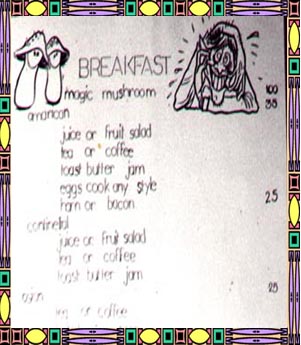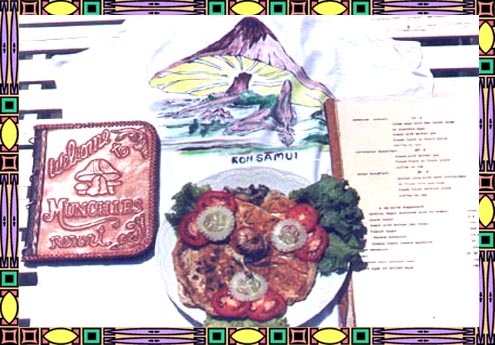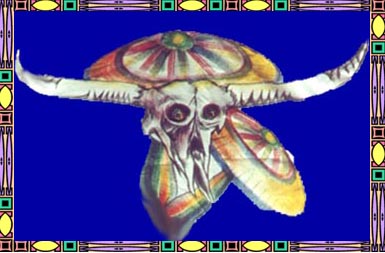

| Originally in the Journal of Ethnopharmacology vol. 35 (1992) 205-228 Copyright by Elsevier Scientific Pulishers, Ireland Ltd. |
| This paper presents the results of recent ethnomycological exploration in southern Thailand. Field observations, interviews and collection of fungi specimens were carried out primarily on two islands, Koh Samui and Koh Pha-Ngan, situated in the western region of the Gulf of Siam. Some fieldwork was also conducted in the northern Thai province of Chiang Dao and in the southern Thai province of Surat Thani. During five separate excursions (1989-90), observations were made of occurrence, harvesting, use, and marketing of psychoactive fungi by local Thai natives (males and females, adults and children), foreign tourists, and German immigrants. The first records of psychoactive Psilocybe subcubensis and Copelandia dung fungi in Thailand are presented in this paper. These fungi exhibited intense bluing reactions when handled, indicating the presence of psilocybine and/or psilocine. Seven collections of Psilocybe cubensis (Earle) Singer and/or Psilocybe subcubensis Guzmán and four collections of Copelandia species were harvested and sun-dried for herbarium deposit. These fungi are cultivated or occur spontaneously, often appearing in the decomposed manure of domesticated water buffalo (Bubalus bubalis) and at least three different species of cattle (Bos indicus, B. Quarus, and B. sundaicus). The psychoactive fungi are cultivated in clandestine plots, both indoors and outdoors, in the uplands and villages on Koh Samui by both Thai natives and some foreigners. The sale of psychoactive fungi directly to tourists and to resort restaurants for use in edible food items such as omelettes and soups is discussed in detail. The preparation and sale of mushroom omelettes adulterated with artificial hallucinogens in some restaurants is also discussed. In addition, the marketing of items such as hand painted T-shirts, post cards, and posters bearing mushroom related motifs in Thailand is described. |
|
Keywords: Psychoactive fungi; Psilocybe spp.; Copelandia spp.; Psilocybin; Hed Keequai; mushroom omelettes |
| Persistent references in the tourist industry literature call
attention to the recreational use of psychoactive fungi in several resort
areas of Thailand, including those on the islands of Koh Samui and Koh
Pha-Ngan. On site observations and personal interviews indicate that
numerous restaurants on the islands of Koh Samui and Koh Pha-ngan have
been serving psychoactive omelettes, stews, soups, pizzas, teas, and
blended juice beverages containing mind-altering, gilled fungi referred to
as "magic mushrooms" and some of these commercial establishments also sell
herb cookies mixed with psychoactive mushrooms and Cannabis ("ganga").
Purchase and use of foods containing psychoactive fungi occurs primarily among tourists and West German immigrants living on these islands. To a lesser degree, use also occurs among other foreigners as well as among some native people (male and female). In addition, some local children also harvest, sell, and consume these fungi, sometimes attempting to smoke the mind-altering mushrooms in bamboo pipes. Occasionally a number of restaurants also sell mushroom omelettes containing an artificial hallucinogen. This hallucinogen (possibly LSD-25) is psychoactively more powerful and potentially more dangerous than the psilocybian alkaloids that occur naturally in some of the wild or cultivated mushrooms collected locally. The following paper describes the psychoactive fungi recorded in Southeast Asia, their ecological association with ungulates, and some aspects of their occurrence, sale, use and psychoactive effects in selected areas of Thailand (see map, figure 1a and lb). |
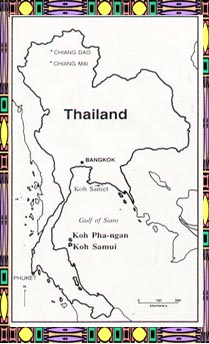
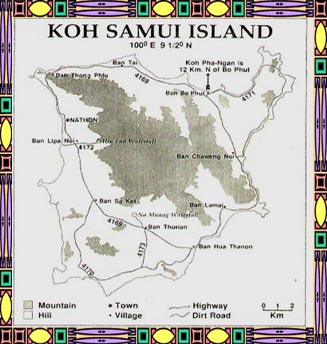
| Mycologists have long been aware that certain species of psychoactive
fungi occur in some areas of Southeast Asia. However, during the past 40
years, only a few, brief references in the scientific literature describe
the occurrence and consumption of mind-altering fungi in this region of
the world (Imazeki & Hongo 1957, 1969; Singer & Smith 1958;
Emboden 1972; Pollock 1976; Unsigned 1978; Cox 1981; Schroeder &
Guzmán 1981). Five species of fungi containing the psychoactive alkaloids
psilocybin and psilocin have been reported in various areas of mainland
(excluding Japan) and insular Southeast Asia (Patouillard 1907; Ola'h
1969; Emboden 1972; Schultes and Hofmann 1973, 1979; Pollock 1974, 1975,
1976, 1977-78; Guzmán 1`983). Recently Panaeolus papilionaceus and
Psilocybe semilanceata have been botanically identified from Pune, India
(Bhide et al 1987); and a form or variety of C. cyanescens has been
reported from Madras, India (Gerhardt, Pers. Comm. to T. Stijve, April 8,
1990). |
| P. cubensis (Earle) Singer, a coprophilous (dung-inhabiting) species,
common in subtropical regions, but unknown in the tropics, was first
identified from a specimen collected in Cuba in 1904 as Stropharia
cubensis (Earle 1906). About the same time, Patouillard (1907) collected
Naematoloma caerulescens (which is now synonymous with P. cubensis) in
Tonkin (Hanoi), North Vietnam. In 1981 (Unsigned 1981), Head magazine, an
ephemeral publication, published a short pictorial which featured mushroom
photographs from the island of Bali. The mushrooms macroscopically
resembled either P. cubensis and or P. subcubensis. Prior to this study, Psilocybe subcubensis, a pantropical and
subtropical species, macroscopically indistinguishable from Psilocybe
cubensis only by the size of its spores, had only been reported from
various regions in Mexico, Central and South America, and Australia
(Guzmán 1983). Although P. cubensis had briefly been mentioned as occurring in
Thailand (Heim and Hofmann 1958; Hofmann et al. 1957; Picker and Rickards
1970; Hofmann 1971; Pollock 1975) no other observations of this species in
Southeast Asia have been recorded in the scientific literature until this
study. It should be noted that some years ago Schroeder and Guzmán (1981)
reported the suspected occurrence of either P. cubensis and/or P.
subcubensis Guzmán from eastern Nepal. Because of customs regulations, no
specimens were forwarded to Guzmán for taxonomic study. Guzmán therefore
had to identify these species using photographs supplied by Schroeder and
from personal accounts of travelers who ingested the fungi during
Schroeder's tour through Nepal. In the summer and early fall of 1989, the senior author (JWA) observed
Psilocybe species north of Hat Yai in the Surat Thani province of southern
Thailand, and on the islands of Koh Samui and Koh Pha-ngan in the Gulf of
Siam (see figure 1). In January 1990, JWA also observed and collected
specimens of either P. cubensis and/or P. subcubensis from buffalo dung
alongside a mountain trail in the Chiang Dao district of Northern
Thailand. |
| The genus Panaeolus is divided into three subgenera: panaeolina
(Maire), Copelandia (Bres.), Anellaria (Karst), and Panaeolus (Fr.) Quel.,
which are determined by the spores (smooth or verrucose) and cystidia
features (see Ola’h 1969,1970). Similar to P. cubensis and/or P.
subcubensis, Copelandia species are also dung-inhabiting. Copelandia species are known to occur in the tropics and neotropics of
both hemispheres. According to Guzmán (1989, pers. comm.), Copelandia
species are considered to be a subgenus of Panaeolus, which includes at
least 8 species (Weeks et al. 1979; Guzmán 1978, 1988, Pers. Comm.).
Pollock (1976) had amended this subgenus into sections which were
originally separated by Ola'h (1968), who classified Panaeolus species
into three catagories: psilocybian, latent-psilocybian, and
non-psilocybian. Although some mycologists refer to the genus Copelandia,
most prefer Panaeolus. According to Guzmán, Panaeolus cyanescens (Berk. et
Br.) Saccardo and Copelandia cyanescens (Berk. et Br.) Singer are the same
fungi following two distinctly different taxonomic paths (Guzmán, 1988.
pers. comm.). In Southeast Asia, the recreational use of P. cyanescens
(syn. C. cyanescens) has been noted from Java, Bali, and the Philippines
(Emboden 1972; Schultes and Hofmann 1973, 1979; Ola'h 1970; Pollock 1976;
Cox 1981; and Lincoff 1987, pers. comm.). Ola'h (1968) identified three species of Panaeolus occurring in various
areas of Southeast Asia: (1) P. cyanescens, (2) P. tropicalis Ola'h, and
(3) P. cambodginiensis Ola'h & Heim. All three of these species are
also common in the Hawaiian Islands (Allen and Merlin 1992a), and the
latter has been reported from Colombia in South America (Pollock
1976). Pollock (1976) also reported P. tropicalis as "fruiting in the dung of cattle and wild animals from Cambodia (Kampuchea)", and, along with Schultes and Hofmann (1973, 1979), Emboden (1979), and Cox (1981), referred to the sale and recreational use of P. cyanescens among tourists at festivals and ceremonies on the island of Bali. While JWA was in Bangkok (1989), several tourists informed him that "magic mushroom" omelettes (and other foods containing psychoactive fungi) were available in several areas of Thailand including Krabbi and the islands of Phuket, Phi-Phi, and Koh Samet. Other traveling informants in Bangkok described similar incidents where they were able to consume "magic mushroom" omelettes in various areas of Indonesia including Sumatra, Java, and Bali (Mood 1988; pers. comm. to JWA 1989). On two separate exploratory excursions into southern Thailand in July and September 1989, JWA collected several specimens (from buffalo dung) of P. cubensis and/or P. subcubensis and three single specimens of an unidentified species of a bluing Panaeolus, section Copelandia. On a fourth visit to the island of Koh Samui in January and February 1990, small collections of both Copelandia and Psilocybe spp. (from cow dung), and Psilocybe sp. (from buffalo dung) were collected for herbarium deposit. Additionally a fifth visit to Koh Samui in July-August 1990 yielded another collection of Psilocybe species, as yet remain unidentified. |
|
Although there are approximately equal numbers of domesticated water buffalo and cattle in Thailand, in the southern region, the former greatly outnumber the latter (by 10 to 1). Among the many types of cattle found in Thailand, the most frequently observed is the Katenq (Bos gaurus). In the southern province of Surat Thani JWA also observed numerous domesticated Bantenq (Bos sundaicus), which have a distinctive golden yellow colored coat. The ungulate ancestors of the the domesticated cattle in Thailand appear to be B. sundaicus, B. guarus, and B. indicus (Johnson 1984). All three of these species have some of the characteristics of B. frontalis; and B. indicus, introduced from India, is perhaps only a domesticated form of B. frontalis (Pendleton 1961; Unsigned 1980, Unsigned 1982). In reference to the coprophilic nature of Psilocybe cubensis, McKenna (1988) recently questioned the origin of this psychoactive mushroom, wondering whether it is "exclusively a creature of the manure of B. indicus, or can it occur in the manure of other cattle?" Although P. cubensis often occurs in association with the manure of B. indicus, especially after heavy rainfall, Schultes (1988, pers. Comm.) indicated that this mushroom species, as well as certain other species of psilocybian fungi, can occur in the manure of other wild ruminants, including species of deer. Guzmán (1983) and Watling (1989, pers. Comm.) also reported that some species of psilocybian fungi have been found in association with Kangaroo feces. McKenna suggested that the origin of P. cubensis can be traced to Kampuchea, but provided very little evidence to support this assertion. He based his assumption on an archaeological excavation in the Non Nak Tha region of Thailand where bones of B. indicus have been unearthed in association with human graves dating from around 15,000 yr. BP (McKenna 1988). In January 1990, JWA collected four specimens of P. cubensis (and/or P. subcubensis) and a few unidentified specimens of Copelandia. These specimens were taken from the manure of cattle (Bos indicus), known in Thailand as Wua (see figure 2). JWA observed more than twenty cattle (Bos indicus and B. sundaicus) at two locations on Koh Samui, and hundreds of water buffalo in various regions of that island. The genus Bubalus contains two subgenera and four species of Asian water buffaloes (Groves 1969; IUCN 1972, 1976). The subgenus Bubalus includes B. bubalis (Asian water buffalo, carabao), distributed from Nepal and India to Vietnam and Malaysia, and B. mindorensis (tamaraw), only found on Mindoro Island (Philippines). The subgenus Anoa includes B. depressicornis (lowland Anoa), found in the lowlands of the Celebes, and B. gaurlesi (mountain Anoa) found in the highlands of the Celebes. The most common water buffalo in Thailand is B. bubalis (see Fig. 3), known in Thailand as "Quai" (Player 1989). "There are two varieties in Thailand: one has dark gray skin and hair; the other has pink skin showing through thin blond hair" (Pendleton 1962). The species is believed to have originated in Nepal and India and today may be found as far east as Vietnam and to the south in Indonesia. Some authors refer to this species as B. arnee (Groves 1969). Although the manure of water buffalo (B. bubalis) and rice paddies (see figure 4) are the primary habitats of psychoactive dung fungi in the southern region of Thailand (the fungi in question can be harvested wherever buffalo may roam). In Surat Thani province, similar dung fungi have also been observed growing in the manure of cattle (B. sundaicus) and in the manure of B. indicus in one field on Koh Samui. During late Fall and early Spring, while rice production is in progress, the majority of domesticated ruminants on Koh Samui are moved from the rice paddies to mountainous terrain (where Thai native cattle tenders harvest the fungi until the cattle are returned to the fields). The Thai people refer to mushrooms as hed and formally call their buffalo quai . Thus, the native Thai phrase for "magic mushroom" hed keequai can be translated as "mushroom which appears after water buffalo defecates". It should be mentioned that JWA also heard the expression hed keequai being used by Thai people in both Bangkok and the northern city of Chiang Mai. |


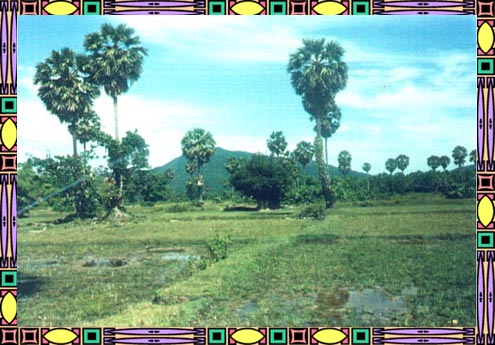
|
In June 1989, JWA was informed by a foreign college student in Hawaii that "magic mushroom" omelettes were being served at restaurant resort areas in Thailand, specifically referring to their sale and consumption on the island of Koh Samet in the northern region of the Gulf of Siam (see Fig. 1). Although the authors were not able to visit Koh Samed to investigate this report, JWA did have the opportunity to visit two other islands, Koh Samui and Koh Pha-ngan, located further south in the Gulf of Siam. JWA visited these islands on five separate occasions (July and September of 1989, January-February 1990, and in July-August 1990). The majority of research was done on Koh Samui. Koh Samui (10 degrees N latitude and 100 degrees E longitude) is located approximately 710 km south of Bangkok and 105 km off of the southern coast of the Thai mainland (see figure lb). It is one of the three main islands in an archipelago comprising 60-80 islands, most of which are relatively small in arial size and uninhabited. Koh Samui has a human population of about 35,000. It is the second largest island in Thailand (280 km), approximately 25 km long, and up to 22 km in width. Mountainous terrain of limestone and granite covers most of Koh Samui, with a maximum elevation of 636 m. Dense vegetation and numerous streams are common. two water falls (Hin Lad and Na Meung) are located off the main road (highway 4169) which encircles the entire island and has many side roads leading into the interior. The more important economic activities on Koh Samui include tourism, fishing, rice cultivation, and extensive copra production. Coconut palms (Cocos nucifera) blanket much of the interior from the hillocks right down to the beaches (approximately 2 million coconuts are shipped each month to Bangkok). The fruits of durian or thurian (Durio zibethinus), rambutan (Nephelium lappaceum), langsat or lansa (Lansium domesticum), and lamyai or longai (Euphoria longana) are also cultivated on Koh Samui. Temperatures on Koh Samui and Koh Pha-ngan range from 25 to 34C.
Psychoactive fungi appear in abundance during the rainy (monsoon) season
which occurs between July and October. However, both Psilocybe and
Copelandia spp. were observed (JWA) being harvested by Thai Samui native
people and foreign immigrants as late as February in
1990. |
| >
Native cattle tenders as well as those who work or reside in and around the rice paddies are very much aware of the effects and commercial value of hed keequai. Many of them harvest (see figure 5) and sell "magic mushrooms" (see figures 6 and 7) to numerous island resort restaurants; some natives also enjoy eating mushroom omelettes (see figure 8) and a few (including some children) were observed attempting to smoke hed keequai in pipes made of bamboo. The habit of smoking "magic mushrooms" may have been taught to the native peoples of Thailand by foreign tourists who could have read of this alleged practice in the undocumented literary works of anthropologist Carlos Castaneda (cf. Casteneda 1969; Ott 1976; Lincoff and Mitchell 1977; Pollock 1977-78; DeMille 1976, 1980). Cox (1981) also reported that this practice is popular amongst some peoples in Samoa. It should be noted that psilocybian fungi are not psychoactive when smoked. Personal communication with numerous adolescent children in the study area on Koh Samui indicated that many in this age group are also well acquainted with hed keequai; several even offered to collect and/or sell the psychoactive dung-fungi to JWA. These children who collect, sell and consume these hed keequai can readily distinguish the "magic mushrooms" from other non-psychoactive coprophilous species found in their environment. Similar sales of psychoactive fungi by native childrem have also been documented from Mexico by Ott (1975) and in Guatamala by Lowy (1977). In December 1988, a Thai law was passed proscribing psychoactive fungi as prohibited plants (see Allen and Merlin 1992b). However, many "bungalow resorts" on Koh Samui still serve "magic mushrooms" in one form or another, if ordered by their customers (before January 1989, many of the more than 200 resorts on Koh Samui and Koh Pha-ngan used small billboard signs to indicate that "magic mushrooms" were available in their establishments). Some resorts also continue to offer "magic mushrooms" in omelettes, soups, stews, and pizzas, as well as in teas and liquefied beverages. One resort restaurant was also observed serving "magic mushroom" herb cookies which contained "ganja" (Cannabis) mixed with hed keequai (cf. Cummings 1981). Although restaurants at various resorts on Koh Samui and Koh Pha-ngan offered a fixed price of 100 Baht ($4.00 U.S.) for a mushroom omelette, the cost varies from 50 to 200 Baht at other commrcial bungalow dining places. Koh Samui children harvest and sell fresh hed keequai to tourists for 100 Baht per ounce or less. Adults may charge anywhere from 100-300 Baht per ounce depending on the season and availability of the fungi. Observations in several Koh Samui homes situated alongside the many rice paddies located throughout Koh Samui, indicated that large food scales are used for weighing the psychoactive mushrooms for sale. Young children and male adults allowed photographs to be taken of them with their mushrooms. The women of Koh Samui, on the other hand, refused to allow such photographs, expressing a fear of police and being arrested because of their association with the fungi (they indicated this by crossing their arms at the wrist as if they had been handcuffed). A few waiters at "Munchies" resort and several other resorts on Koh Samui and Koh Pha-ngan asked the senior author where they might also collect specimens of hed keequai for their establishments. |

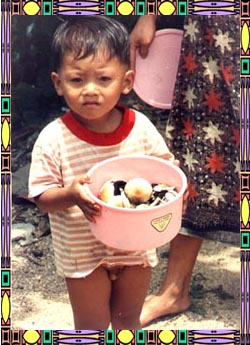
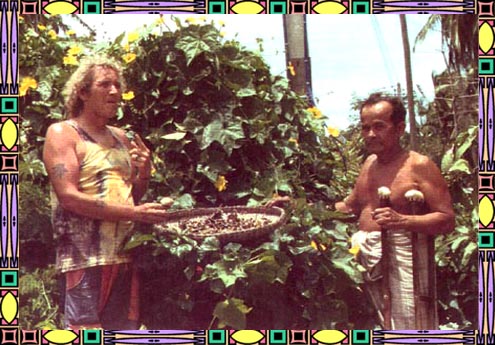
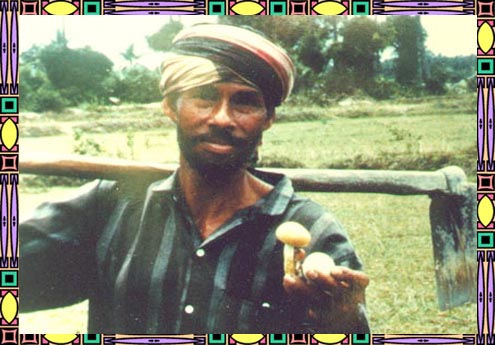
| In the fall of 1988 tourist police on Koh Samui and Koh Pha-ngan
circulated printed sheets of paper (flyers) to all bungalow resorts. These
issued a warning that mind-altering mushrooms (hed keequai) were dangerous
(antaray) and made people crazy (`ae tam hai ben baa). The flyers also
noted that these fungi were illegal. An official "tourist police officer"
interviewed in the village of Ban Nathon reported that a young Austrian
tourist experienced a dysphoric reaction after ingesting a large quantity
of psychoactive fungi consumed in a "magic mushroom" tea. According to the
police officer, this young man, in his early twenties, manifested
extremely bizarre behavior as a result of his intoxication and was
consequently committed to a mental institution by a Thai judge. He
remained in the institution for four months before being released. As a
result of this incident, and a few similar, but less serious, events, the
Thai government banned the use of hed keequai in Thailand.
A somewhat different, more descriptive and interpretive analysis of this incident was also offered to JWA by a German immigrant who had worked at one of the many "magic mushroom" farms that no longer openly operate on Koh Samui. According to this informant, in 1988 the young foreign tourist, while celebrating his birthday over a three day period, ingested Cannabis, opium and psilocybin mushrooms, while continuously consuming alcohol. On his birthday, he allegedly brewed and consumed a psychoactive mushroom tea utilizing over two pounds of fresh hed keequai. In addition, he allegedly ingested heroin, along with the other psychoactive substances. Because of his subsequent anti-social behavior the tourist was indeed institutionalized for a period of four months by a Thai magistrate. Upon his release, the youth was described as coherent only briefly, and more often acted " looney as a bird". Because of the above mentioned incident, the numerous signs advertising "magic mushrooms" were removed from in front of the various resorts along highway 4169, and a majority of the restaurants on Koh Samui and Koh Pha-ngan also removed "magic mushroom" omelettes from their menus. In July 1989 JWA obtained a menu from "Munchies" resort (see figure 9); and as recently as December 1989, JWA obtained a menu from a new resort on the island of Koh Pha-ngan (see figure 10). Both menus listed "magic mushrooms" as edible items for sale. At "Munchies" resort in Hat Chewang, Koh Samui, which provides business cards portraying mushrooms, JWA and his Scottish traveling companion bought and consumed a "magic mushroom" omelette. The effects and symptoms produced by this omelette lasted for almost ten hours, much longer than the normal duration of a psilocybin mind- altering experience. This single experience caused the Scottish traveler some minor psychological distress which lasted for at least two months; in a private communication (1989), he stated that since returning to his home in Glasgow he was still hesitant to eat any omelette containing mushrooms. The local native waiters who served the omelette at Munchies resort, referred to the mushrooms in the omelette simply as "magic". The manager of the restaurant claimed that the cook was the only person who knew what had been put into the omelette. Attempts to dry and preserve the omelette for laboratory study proved futile. During the second excursion of JWA to Koh Samui (September 1989), another omelette was ordered which actually contained Psilocybe mushrooms (see figure 11 and 12). Observations and personal interviews (July 1989) with restaurant and bungalow managers at resort restaurants on Koh Samui indicate that 27 serve omelettes containing psilocybin mushrooms and three which admitted serving omelettes containing a more powerful synthetic or semi-synthetic hallucinogen ("LSD"). When the mushrooms are in season they are available to the restaurants; however, a supply of LSD has apparently been made available to restaurants at several resorts. One of the present authors (JWA) observed A few German immigrants posting dried hed keequai to friends in Germany. These immigrants were not aware of naturally occuring psychoactive fungi in their country nor were they aware of the LSD adulterated fungi sold in their homeland. Stahl, Brombeer, and Eskes (1978) were the first to report the sale in Germany of Shitake LSD adulterated fungi. These fungi were from Southeast Asia. Similar fungi, adulterated with LSD and PCP, (Aqaricus camaestris and/or A. bisporis) have been available for sale in the United States since the late 1960s (Ott 1976, 1978). Stijve (pers. Comm., 1989) also reported that these adulterated fungi are still being sold on the illicit German drug market. A female informant from Sweden, who observed the senior author's consumption of the hallucinogenic omelette (possibly laced with LSD), claimed that she had observed two people who had experienced a two day dysphoric experience after consuming a "magic mushroom" omelette at another resort ("Big Buddha") in the northeast region of Koh Samui. Other tourists also reported observing similar dysphoric reactions elsewhere in Koh Samui. |

